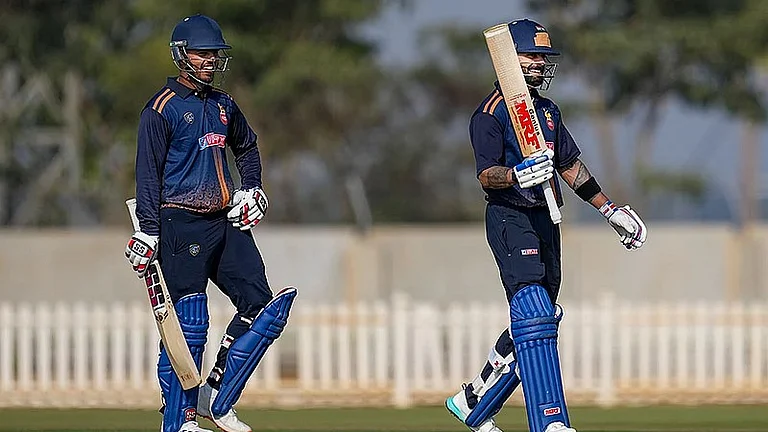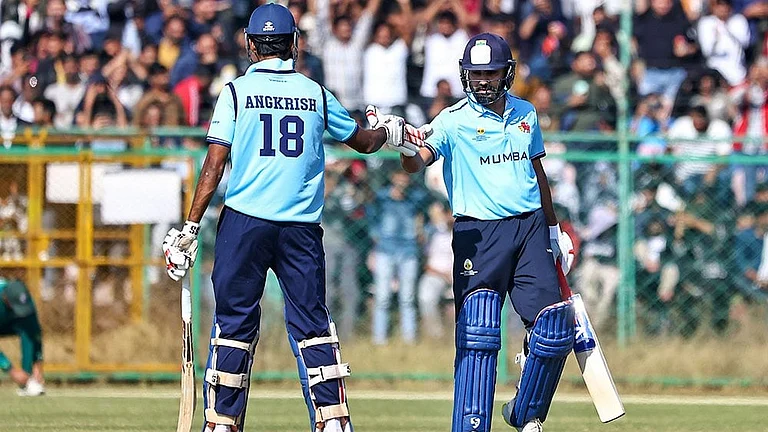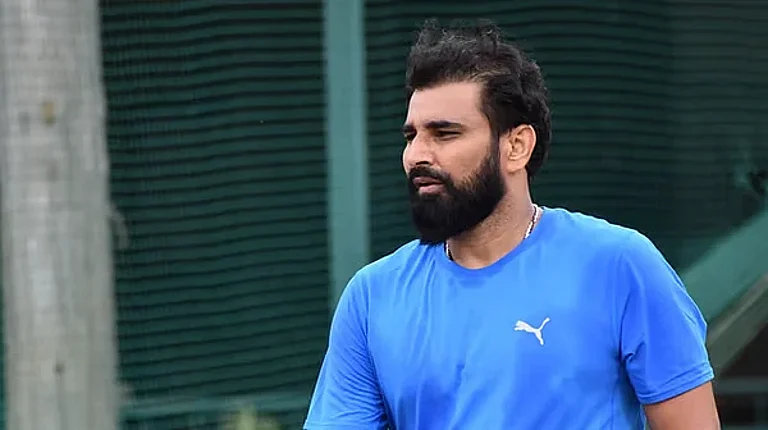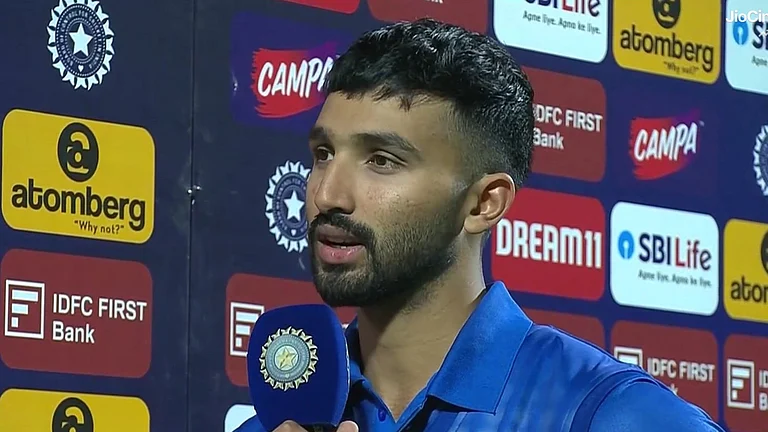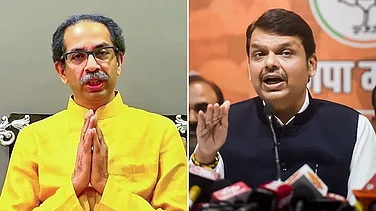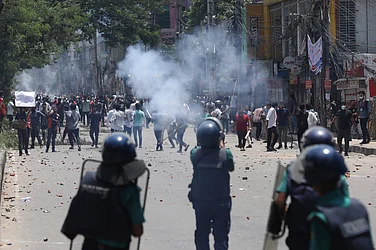When the air is vacuum-cleaned of real information, what fills it is the elements of empty anticipation. Rumour, speculation, fear…all these form a suspended particulate matter that we then breathe in. The latest talk doing the rounds was that India would duck back into hibernation—into a strict lockdown—by the middle of June or so. Since Indians are familiar with the phenomenon of a late-evening broadcast fundamentally altering their realities, appending a ‘could be’ or ‘maybe’ on that rumour is pointless. But the reason why the situation spawns such speculation is clear.
India’s Covid graph has been curving up in an unbroken geometric progression—regardless of lockdown. Then, in phases since May 3, India has been also opening up: ‘Unlockdowning’. For eyes long shut, the light outside was blinding. After our first coronavirus case on January 30, India had taken 45 days to reach 100. Nine days later, as the lockdown started on March 24, we were around 500. But six weeks later, on May 6, just after we exited strict lockdown, we had zoomed to 50,000! The localised surges consequent to opening up bent that curve further upward, like surf on the sea. In another four days, we reached a lakh. As we go to print, we’re just 20,000 short of 3 lakh, with 1.3 lakh active cases. It has been messy and cheerless.
As we adjust our retinas, what do we see? COVID-19 as a radiating pain, a shifting, pulsating, intensifying migraine. Some parts of the body in extreme distress; the big cities beginning to choke, with their available ICU bed-to-patient ratio looking alarming; new areas of the hinterland in trauma; even hitherto healed regions plunged anew into a spreading gloom. Karnataka had had its first Covid +ve case on March 8, but expended good energy on dragging it out—it took 65 days, till May 12, to reach the 1,000-case mark. But that, alas, was when ‘Unlockdown 1.0’ was already in motion. The next 1,000 cases took a mere 10 days; then eight days; then three days; then four again. As of June 10—another four days—it was on track to hit 6,000 cases with over 3,000 active cases. Manipur had registered the Northeast’s first case on March 24, but touched only 29 in the next two months. Over the next fortnight, by June 10, it was aiming for 300, with only 61 cured. Kerala, famously, took nearly two full months to reach 100 after inaugurating India’s first case on January 30, then sloped up gently to 800-plus over the next two months. That doggedness went waste when, in one day after domestic flights resumed on May 25, it took a standing leap to 1,326—now it gloomily contemplates 2,000, out of which over 1,200 are still active patients.
But economic exigencies mean Unlockdown is inevitable. The question is: How to open up? What can be the mechanics of doing it in modulated, calibrated ways—where you can loosen the tourniquets on our starving economy, while at the same time lassoing down the rampaging virus. A bit like an ICU doctor handling a critical patient with multiple points of contraindications. The layperson wants to know, even more anxiously, if COVID-19 will get him or her sooner or later—the chances of that happening now are infinitely higher, especially if actual infections out there are close to a million, as some estimates go. Epidemiologists and data experts, on the other hand, are groping in the dark about the shape the epidemic graph will take. In what way, on which parts of the map, will it spread further? And what does the much-talked-about ‘peak’ look like? Most crucially, can we alter it?
Simply, the ‘peak’ stands for that point on the graph after which the number of infected people starts declining. There’s, of course, no sign yet of that Mount Meru, the tip of the pagoda. At present, as the government ramps up testing, India’s caseload is only showing a daily upward trend. At the peak, the ‘R0’ value tips over to less than 1 (see Lockdown story)—this means an infected person infects less than one person, so you start descending to the valleys. Now, if 50 per cent of the population is infected, the R0 automatically dips below 1 (see Muliyil interview). But many experts say India should not wait for that—a crucial part of epidemiology policy relates to this. Depending on how policy affects the trajectory, experts have also predicted different months, from July to November, for when the peak will arrive. But no one knows what it looks like: how many Indians being Covid+ve at one time. The concept of a peak throws open a whole lot of questions. Should we not look for one peak—and see different states as having different peaks? What about rural and urban regions within a state? It’s important to capture the dynamics of a disease—that helps us ensure we are as medically prepared as possible. It’s not a question of choosing one mathematical model to calculate the infection rate—there are many—as the most convincing and final. The real complexity is due to the varying rates in each state. Some, like Maharashtra and Delhi, witnessed a quick surge; others are catching up now.

To understand the peak in the context of India, the Department of Science & Technology (DST), under the guidance of the Jawaharlal Nehru Centre for Advanced Scientific Research (JNCASR) and IISc, Bangalore, is trying to create a new model that integrates “the best features” of hundreds of existing models sourced from government and private bodies (they’re calling it, well, the ‘supermodel’). “The consultative committee was formed last week, formal proceedings have just begun,” says A.N. Jayachandra, secretary, JNCASR. The idea is to arrive at a predictive tool with the same prescience as meteorological tools that do weather forecasting. To get there, it’s mapping the pandemic across the globe, trying to understanding the factors that led to specific events, and weaving that into their grid. The model should be ready in a few weeks. “Using the Susceptible-Infected-Exposed-Recovered-Dead (SEIRD) model, the infection rate in India at the end of May (averaged from May 18-31) was at around 8.5 per cent, which is definitely better than what we started with, around 24 per cent, but also far from the peak. This is a highly simplified model; we are working on more hyperlocal models to derive the ‘supermodel’ now,” says Ashwin Srivastava, co-founder and CEO, Sapio Analytics. Sapio is part of the ongoing exercise.
Why is predicting the ‘peak’ a challenge?
Data scientists say it’s the quality of data—any presumptive model can only be as good as the data that feeds it. Correct reporting of data—and enough tests to cover an acceptable sample—is not exactly forthcoming from every part of India. Scientific assumptions have to fill in the blanks. A section of experts says the peak should be seen as happening state-wise, and should be calculated differently for rural and urban regions within a state. “At this moment, it’s practically impossible to suggest a peak for India. Any model that does so is (deficient of) required parameters,” says Srivastava. Positing a peak anywhere from August to November, they also say this range can change significantly based on policy decisions. Manoj V. Murhekar, director, National Institute of Epidemiology (NIE), also prefers caution. “I have no idea what the peak will be like and how many infections will make the peak. Experts have given various deadlines, none has come true,” he says.
Modelling the peak on the basis of, say, Italy or US, poses its own issues. “Many European countries contained the infection within a geographical limit; in India, we have allowed it to travel the length and width of the country,” says Bhupesh Daheria, CEO, Aegis School of Data Science. State health officials admit the lockdown relaxation and resumption of air-services, along with the earlier displacement of migrant workers, took COVID to Tier II-III cities and beyond. Many districts in Bihar, Jharkhand, UP, Odisha have witnessed a sudden rise in cases of late. The Northeast, barring Assam, Meghalaya, Manipur and Tripura was completely COVID-free and in the green zone till May 25. Dadra Nagar Haveli didn’t have a single case. Not so anymore—these places have turned into red zones with cases being reported from even remote districts. Mizoram initially had only one case, with a recovery, says the state’s Integrated Disease Surveillance Programme (IDSP) officer, P. Lalmalsawma—“now we have 88”.
Health experts point to the irony of opening up after the lockdown itself forced migrant abour back to their native places—bad economics, bad pandemic control. “We created a huge shortage of workforce in our factories while allowing the infection to travel all across India,” admits a senior epidemiologist. A lot of villages in, say, Bihar and UP converted government schools, banquet halls and community centres into quarantine centres to contain the infection. But many smaller cities and state capitals failed to track the incoming population due to the sheer numbers. Patna, for one, is at serious risk. Containment is the initial strategy; if the infection explodes, one has to resort to mitigation.
How to stop health system from getting overwhelmed
One of the biggest advantages of the lockdown, claimed the government, is that it provided time to upgrade the health infrastructure to meet the demand (see box). Contrary to that claim, cities like Delhi, Mumbai, Ahmedabad and Indore have started facing an acute shortage of beds in hospitals; patients saying they have to run from one hospital to another is a common scare-story—in many cases, even dying in transit for want of treatment. That suggests the health system is already overwhelmed: not a good omen, with the peak still far from sight. State governments like Delhi dismiss news reports and public claims about a shortage of beds, but all the signs are that resources are drying up. For one, the various restrictions on treatment and testing; for another, the strange decision in which the Delhi government prohibited people from the National Capital Region from availing any hospital facility in Delhi. (The order has been overruled by the LG.)
The Delhi government claims it has a total of 8,575 dedicated COVID beds right now—4,413 occupied, 4,162 vacant—including government and private. It has also developed a mobile application in which anyone can check this availability. But patients say the app shows something, and the hospitals something else when they reach there. Black-marketing of beds is also being spoken of. One scary indication of the shortage—present and/or imminent—came from the deputy CM, where he said Delhi would need 80,000 beds by July end, when the state’s caseload is expected to touch 5.5 lakh. The Union health ministry said there were a total of 1,33,632 Covid +ve patients in India as on June 10—an exact break-up of admitted patients is a matter of loose reckoning, because mild/asymptomatic patients are advised home quarantine.
Many states had initially kept private hospitals out of the ambit of COVID-19 but are now rethinking their strategy. Uttar Pradesh didn’t allow a single private hospital to treat COVID-19 patients—not even those willing to bear the costs. Karnataka too. “At present, all COVID hospitals here are government hospitals,” says Nandakumar Jairam, CEO, Columbia Asia Hospitals. The government “may involve private healthcare” if the numbers increase. Delhi initially had only three private hospitals roped in for COVID. “But of late, the state has asked all private hospitals to either completely get converted to COVID-19 hospitals or reserve 20 per cent beds for it,” says Mahipal Singh Bhanot, zonal director, Fortis Hospital. Mumbai has followed a different strategy. It has demarcated some hospitals as quarantine centres for patients who are asymptomatic, mildly symptomatic and severely symptomatic/high risk respectively. The state government has asked all private hospitals to ramp up capacity. It has also notified that 80 per cent of total operational beds (both COVID and non-COVID) will be regulated as per rates specified by the government.

Stacks of ash urns of the dead during the lockdown
But hospitals have their worries: severe shortage of staff, especially non-medical staff like nurses, housekeeping, ward boys etc. Many non-medical staff have got infected, absenteeism is high, many are leaving due to fear of catching the infection—Maharashtra, the current hotspot, is grappling with an exodus of sorts. “We need to understand that our frontline healthcare workers are putting themselves at risk, sacrificing their personal lives and working round the clock. They need to be counselled, kept motivated,” says Gautam Khanna, CEO of Hinduja Hospital, Mumbai.
Also Read | Does India Have A Milder Epidemic? Not Really
The treatment cost also becomes a bone of contention as soon as private healthcare comes in: many patients complain of overcharging. Experientially, most Indians will say that’s true, but it’s not always easy to judge. “When an allegation of overcharging is made, we need to have a standard or mean to judge it by. In its absence, any rate can well be called arbitrary,” says Nishant Srivastava, managing partner, Actus Legal Associates. The FICCI health services committee recently proposed that treatment costs be fixed between Rs 17,000 to Rs 45,000 depending on the facilities. The government hasn’t taken any call on it yet. “Various state governments have announced separate policies for reimbursement of care given to COVID-19 cases,” says Dr Harish Pillai, member of the FICCI committee. This is one end of the drama unfolding across India—private healthcare in the midst of a very urban nightmare. Other, less visible nightmares stalk the countryside.
****

ICMR ramps up capacity but controversies abound
The ICMR website shows that, as on June 9, the total number of samples that India has tested was 1,45,216. On May 20, it also claimed that, in just 60 days, it made a 1,000 per cent progress in the country’s testing capacities. On January 30, when the first Covid-19 patient was found in Kerala, there was only one lab under ICMR: the National Institute of Virology, Pune. Even till mid-February, samples of Covid-19 patients were being air-lifted from various locations and brought to Pune for testing. Today, ICMR has approved 590 government labs and 233 private labs across India country for the three kinds of tests currently being done to test for the Covid: rRT PCR, TrueNat and CBNAAT.
Initially, rRT PCR—or Real-Time Reverse Polymerase Chain Reaction—was the only confirmatory test for Covid-19. Out of the three tests it was seen as the most reliable, but it entails complex steps: a specially manufactured swab to collect throat or nasal secretion, a special fluid called viral transport medium (VTM) to transfer the swab to the lab, a viral extraction kit to tease out the virus from the swab, and then finally an rRT-PCR kit to test for viral presence. Even with all four elements present, if personal protective equipments (PPEs) were not available for those engaged in the process, testing could not be initiated. Everything needed to be there, at once.
Naturally, that limited the scope of its applicability. Considering the urgency of the situation and the need to ramp up testing, ICMR then approved TrueNat (a test for drug-resistant tuberculosis) and CBNAAT (cartridge-based nucleic acid amplification test) as part of the testing arsenal. “While rRT-PCR is limited to well-equipped hospitals, TrueNat can be deployed at district hospitals across India, addressing the last mile barrier,” says Dr Rajni Kant, Head, Research Management, Policy, Planning and Coordination, ICMR. Till date, 240 labs for TrueNat and 63 for CBNAAT has been given approval. The Council now says it has “developed and validated the completely indigenous IgG ELISA test for antibody detection for SARS-CoV-2.” It has transferred this technology—which it calls ‘Covid Kavach’—to seven companies that are expected to get manufacturing licences from the Central Drugs Standard Control Organisation (CDSCO) in a month.
In April, the Council also faced flak for buying a China-manufactured rapid-test kit that was supplied to all states. The kits had to be withdrawn after some states reported erroneous results. Though ICMR claims it incurred no financial loss as no money was paid to the company, the lack of due diligence that led to the goof-up and the ambiguity in financial dealings raised questions. Not to mention the waste of precious time and manpower in the middle of a pandemic.
***
Available COVID-related health infrastructure as of June 5, 2020
- 957 dedicated COVID hospitals with 1,66,460 isolation beds, 21,473 ICU beds and 72,497 oxygen-supported beds.
- 2,362 dedicated COVID Health Centres with 1,32,593 isolation beds, 10,903 ICU beds and 45,562 oxygen-supported beds.
- 11,210 quarantine centres and 7,529 COVID Care Centres with 7,03,786 beds.
- 128.48 lakh N95 masks and 104.74 lakh PPEs provided to states/ UTs/central institutions







